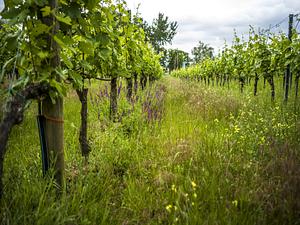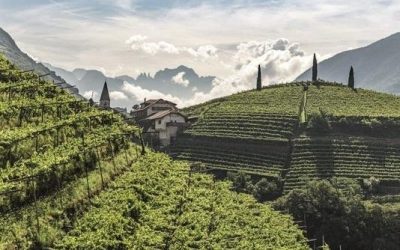
© ÖWM / Carletto Photography
The fact that Austria produces world-class white wines is nothing new. However, in recent years, Austrian reds have been following hot on their heels, making headlines with their top international ratings. And it is no wonder, for it has almost been one outstanding vintage after another since 2015. Zweigelt, Blaufränkisch, Sankt Laurent and the likes have produced juicy, ripe red wines full of fruit and with all the typical freshness of Austrian wines.
There are many factors that come together to make a good red wine, but one of the most important is the climate. And this is especially good news for Austria, given that weather conditions have been exceptionally favourable since the 2015 vintage. Thanks to the warm summer and golden autumn months, the grapes in the classic red-wine regions – primarily Burgenland, but also Carnuntum and the Thermenregion – have been able to achieve optimal ripeness. This has enabled the winemakers to exploit the full potential of their grape varieties and terroirs, producing exceptionally powerful red wines with an outstanding structure and depth of flavour. At the same time, sufficient precipitation and cool nights during the ripening phase have ensured they retained the typical freshness that makes Austrian wines unique. This has resulted in red wines that are not only powerful and full-bodied, but also elegant and full of finesse – and that holds equally true for monovarietal red wines and cuvée blends.
Velvety red with delicate spiciness
When talking about Austrian red wines, there’s no getting around Zweigelt (Rotburger). Nowadays, this crossing of Blaufränkisch and Sankt Laurent is grown on around 6,000 hectares of land, in other words, almost half of the area dedicated to red wine varieties in Austria. And there is good reason for this! Zweigelt is a charmer with velvety tannins and deep fruity aromas of morello and dark cherries, combined with a confit of forest fruits. Does that sound a bit kitsch? Well it isn’t, because a delicate spiciness is what gives Zweigelt its vital pizzazz. Served a little cooler, a light Zweigelt is also the perfect drink to enjoy on the patio in summer. And while the appeal of a young Zweigelt is well-known, a growing number of connoisseurs are discovering the delights of these wines when they have had a chance to mature. With ageing, the tannins become even more refined and the flavour profile is enhanced by notes of mocha and leather.
A mature performance: one top vintage after the other
While on the subject of maturity, those who aren’t browsing the stocks of Austria’s red-winemakers right now are passing up a unique opportunity. Perfectly matured red wines from the historic 2017, 2019 and 2021 vintages are still available, for example, as well as the delicately fruity and precise 2020 and 2016 wines. Those who prefer something that packs more of a punch in the glass should consider the dense and powerful 2018 vintage. These mature reds display all the charisma that Austria has developed in this area. Their flavour components have settled into the perfect balance, while the wines have still retained their typical freshness and are as juicy as ever.
Character, character, character
Another wine that has particularly benefited from the recent good wine-growing years is Blaufränkisch – a character actor that has established Austria as one of the top red-wine producing countries, especially at the international level. As a late-ripening variety, the warm summers and mild autumns particularly suit Blaufränkisch. This enables its unmistakeable foundation, grippy tannins and vibrant freshness to ripen to perfection, allowing it to develop deep-rooted aromas of dark berries, a spicy, smoky minerality and the occasional vivid floral note. Virtually no other variety expresses the typicity of its origins in the glass quite as well as Blaufränkisch.
The sophisticated grape with a sugar brake
The third variety that plays a key role on the Austrian red-wine scene is Sankt Laurent. It is, without question, an absolute diva in the vineyard. However, it is also a grape that appears made for climate change, since it has a natural sort of “sugar brake”. This prevents the grapes from storing too much sugar, even in warm years. As a result, the wines are never too heavy, developing an incomparable elegance and sophistication instead. They are mild and fruity, almost silky on the palate, and display aromas of dark forest fruits, cherries and a hint of forest floor that is reminiscent of illustrious Pinot Noirs.
And if one variety is not enough…
In addition to the monovarietal Austrian red wines, Austrian winemakers also produce international-standard red wine cuvée blends. They often use Zweigelt or Blaufränkisch as a base, supplemented by Merlot or Cabernet Sauvignon. And fans of classic Burgundy cuvée blends will also find what they are looking for in Austria – at much more appealing prices.Our recommendation: Fresh and fruity red wines are particularly charming when served at 14–16 °C. Mature and powerful reds or cuvée blends, on the other hand, show off their multi-faceted aromas to best effect at 16–18 °C.
The time for Austrian red wines is now
So when is the best time to open a bottle of Austrian red wine? That’s an easy one to answer – any time! They are the perfect pairing partners for a wide range of dishes, such as game, beef or tangy cheeses, as is well known. But red wines also elevate dishes containing grilled vegetables, mushrooms or pulses, especially if you choose a delicately fruity Zweigelt or Sankt Laurent.
However, you don’t have to wait for a meal to open a good bottle of red wine. Many other occasions bring out the true pleasurable potential of Austrian reds, such as an evening spent chatting with friends, or a glass enjoyed sitting in front of a roaring fire – especially when temperatures begin to drop outside. Indeed, there’s never been a better time to discover Zweigelt, Blaufränkisch and Sankt Laurent, along with all of Austria’s other fascinating reds.
About Austrian Wine
The Austrian Wine Marketing Board (Austrian Wine), based in Vienna, is a national service body for the Austrian wine industry. It was founded in 1986 with the aim to strategically support, coordinate and maintain quality and sales. The company’s goal is to maintain the high shares of Austrian wine on the domestic market. At the same time, it is also aiming to grow wine exports, by placing the focus on value creation.










